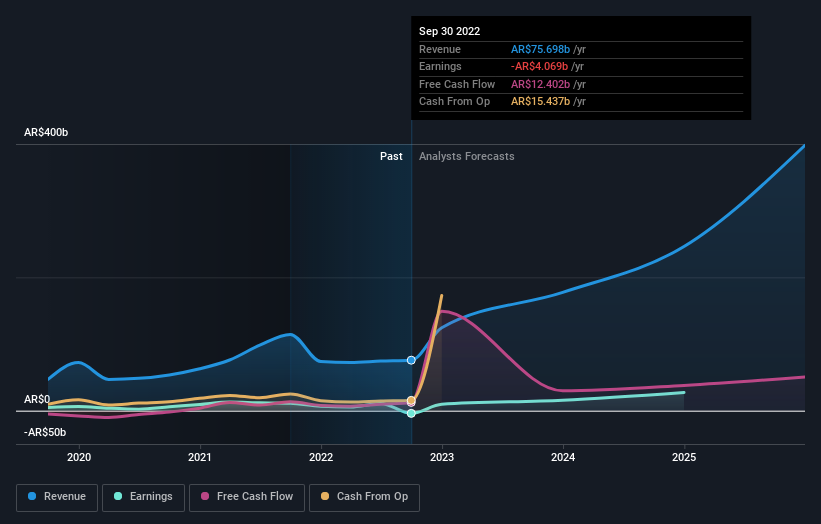While individual investors own 23% of Loma Negra Compañía Industrial Argentina Sociedad Anónima (NYSE:LOMA), private companies are its largest shareholders with 52% ownership
Key Insights
The considerable ownership by private companies in Loma Negra Compañía Industrial Argentina Sociedad Anónima indicates that they collectively have a greater say in management and business strategy
52% of the company is held by a single shareholder (Participações Morro Vermelho S.A.)
20% of Loma Negra Compañía Industrial Argentina Sociedad Anónima is held by Institutions
Every investor in Loma Negra Compañía Industrial Argentina Sociedad Anónima (NYSE:LOMA) should be aware of the most powerful shareholder groups. With 52% stake, private companies possess the maximum shares in the company. That is, the group stands to benefit the most if the stock rises (or lose the most if there is a downturn).
And individual investors on the other hand have a 23% ownership in the company.
Let's delve deeper into each type of owner of Loma Negra Compañía Industrial Argentina Sociedad Anónima, beginning with the chart below.
Check out our latest analysis for Loma Negra Compañía Industrial Argentina Sociedad Anónima
What Does The Institutional Ownership Tell Us About Loma Negra Compañía Industrial Argentina Sociedad Anónima?
Institutional investors commonly compare their own returns to the returns of a commonly followed index. So they generally do consider buying larger companies that are included in the relevant benchmark index.
Loma Negra Compañía Industrial Argentina Sociedad Anónima already has institutions on the share registry. Indeed, they own a respectable stake in the company. This suggests some credibility amongst professional investors. But we can't rely on that fact alone since institutions make bad investments sometimes, just like everyone does. It is not uncommon to see a big share price drop if two large institutional investors try to sell out of a stock at the same time. So it is worth checking the past earnings trajectory of Loma Negra Compañía Industrial Argentina Sociedad Anónima, (below). Of course, keep in mind that there are other factors to consider, too.
Our data indicates that hedge funds own 5.0% of Loma Negra Compañía Industrial Argentina Sociedad Anónima. That's interesting, because hedge funds can be quite active and activist. Many look for medium term catalysts that will drive the share price higher. Participações Morro Vermelho S.A. is currently the largest shareholder, with 52% of shares outstanding. With such a huge stake in the ownership, we infer that they have significant control of the future of the company. Capital Research and Management Company is the second largest shareholder owning 7.1% of common stock, and Argentine Social Security Administration holds about 5.3% of the company stock.
Researching institutional ownership is a good way to gauge and filter a stock's expected performance. The same can be achieved by studying analyst sentiments. There are plenty of analysts covering the stock, so it might be worth seeing what they are forecasting, too.
Insider Ownership Of Loma Negra Compañía Industrial Argentina Sociedad Anónima
The definition of company insiders can be subjective and does vary between jurisdictions. Our data reflects individual insiders, capturing board members at the very least. Company management run the business, but the CEO will answer to the board, even if he or she is a member of it.
Insider ownership is positive when it signals leadership are thinking like the true owners of the company. However, high insider ownership can also give immense power to a small group within the company. This can be negative in some circumstances.
We note our data does not show any board members holding shares, personally. It is unusual not to have at least some personal holdings by board members, so our data might be flawed. A good next step would be to check how much the CEO is paid.
General Public Ownership
The general public-- including retail investors -- own 23% stake in the company, and hence can't easily be ignored. This size of ownership, while considerable, may not be enough to change company policy if the decision is not in sync with other large shareholders.
Private Company Ownership
Our data indicates that Private Companies hold 52%, of the company's shares. It's hard to draw any conclusions from this fact alone, so its worth looking into who owns those private companies. Sometimes insiders or other related parties have an interest in shares in a public company through a separate private company.
Next Steps:
I find it very interesting to look at who exactly owns a company. But to truly gain insight, we need to consider other information, too. For instance, we've identified 1 warning sign for Loma Negra Compañía Industrial Argentina Sociedad Anónima that you should be aware of.
If you would prefer discover what analysts are predicting in terms of future growth, do not miss this free report on analyst forecasts.
NB: Figures in this article are calculated using data from the last twelve months, which refer to the 12-month period ending on the last date of the month the financial statement is dated. This may not be consistent with full year annual report figures.
Have feedback on this article? Concerned about the content? Get in touch with us directly. Alternatively, email editorial-team (at) simplywallst.com.
This article by Simply Wall St is general in nature. We provide commentary based on historical data and analyst forecasts only using an unbiased methodology and our articles are not intended to be financial advice. It does not constitute a recommendation to buy or sell any stock, and does not take account of your objectives, or your financial situation. We aim to bring you long-term focused analysis driven by fundamental data. Note that our analysis may not factor in the latest price-sensitive company announcements or qualitative material. Simply Wall St has no position in any stocks mentioned.
Join A Paid User Research Session
You’ll receive a US$30 Amazon Gift card for 1 hour of your time while helping us build better investing tools for the individual investors like yourself. Sign up here

 Yahoo Finance
Yahoo Finance 

